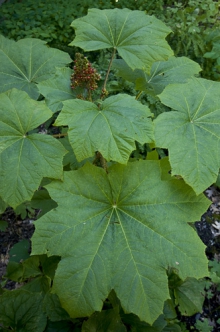By
Hannah Bauman
 In
May 2020, the American Herbal Pharmacopoeia (AHP) announced the publication of a
combined monograph and therapeutic compendium for devil’s club (Oplopanax horridus, Araliaceae) bark of
decumbent stem, root, and lower stem.1 According to AHP, this is the
first pharmacopeial monograph developed for this North American botanical and
the 41st published by the organization. In
May 2020, the American Herbal Pharmacopoeia (AHP) announced the publication of a
combined monograph and therapeutic compendium for devil’s club (Oplopanax horridus, Araliaceae) bark of
decumbent stem, root, and lower stem.1 According to AHP, this is the
first pharmacopeial monograph developed for this North American botanical and
the 41st published by the organization.
AHP
monographs establish authenticity, purity, and quality standards for raw
materials and finished preparations. The therapeutic compendia provide a
comprehensive review of pharmacological and safety data, including medical
indications, modern and traditional uses, structure and function claims,
dosages, interactions, side effects, contraindications, pharmacokinetics,
pharmacodynamics, toxicology, and more. This information can be used by
individuals in the herbal community, from consumers and practitioners to
quality control personnel and dietary supplement manufacturers.
Devil’s
club grows in well-drained soil in old-growth forests and adjacent to marshy areas
and streambanks.2 Erect stems can be three meters (10 feet) tall with
spines up to three centimeters (one inch) in length, broad, palmate leaves, and
sprawling growth habit as a result of its shallow root system. Its tall growth
and formidable spiny stems are likely the source of the plant’s common name. It
reproduces by vegetative layering, which is generally caused when stems are
weighed down by snow. Vegetative layering occurs when new shoots anchor the
stem to the forest floor and, when covered with soil, eventually form new roots
and rhizomes. Sustainable harvesting of devil’s club is an ongoing concern because
the medicinal parts used most often is the root and lower stems, which impacts
the plant’s ability to regenerate. Habitat loss is also a concern. The plant
does not thrive in clear-cut areas without tree cover. Cultivation efforts have
produced few successes, as devil’s club does not transplant easily outside of
its native habitat and seed germination is poor.
Devil’s
club is relatively unknown in the global market, but in its native growing
area, which includes most of the Pacific Northwest, it is a significant part of
the medicinal and spiritual practices of Native American and First Nations
peoples. Historically, the bark was chewed, decocted, or infused into oil as an
appetite stimulant, a counterirritant for arthritis and rheumatism, an emetic,
and for conditions such as fever, stomach pain, and respiratory ailments. It
was also used for the management of diabetes and tuberculosis. As a spiritual
aid, devil’s club was considered protective, and the wood and bark were
fashioned into luck charms and amulets to ward off witchcraft and bad weather,
or infused into ritual baths for purification and protection. The species is
not related to the similarly named devil’s claw (Harpagophytum procumbens and H. zeyheri, Pedaliaceae).
Naturopathic physician Eric Yarnell, ND, RH (AHG), president of Heron Botanicals, uses devil’s club preparations often in his practice. Yarnell underwrote the creation of the
monograph through his company. “I felt it was important to share some of the
herbal wealth of the Pacific Northwest more widely,” he wrote (email, June 9,
2020). “I use Oplopanax primarily as an immunomodulating adaptogen with
a lung affinity. I think this wonderful herb has really been oversimplified as
just an anti-diabetic remedy and it is time to realize it has much wider
actions.”
In
the modern Western herbal tradition, devil’s club primarily is used in tincture
or decoction form to support digestive health and mitigate minor
gastrointestinal upset. However, in large doses, it is an emetic. It is also
used for its anti-tussive effects to soothe coughs and sore throat. Though
human clinical trials are lacking, some constituents of devil’s club bark have
shown cytotoxic and antituberculosis activity in vitro. Specifically, polyynes
in devil’s club have shown activities against numerous cancer cell lines,
including colorectal, breast, lung, ovarian, pancreatic, and leukemia.
According
to AHP Executive Director Roy Upton, RH, DipAyu, who edited the devil’s club monograph
and therapeutic compendium: “We love giving attention to botanicals that are
native to North America and have not been monographed anywhere else in the
world. Giving these botanicals some focused attention provides a unique
contribution to the botanical medicine literature that otherwise may not happen”
(email, May 27, 2020).
American
Botanical Council (ABC) Chief Science Officer Stefan Gafner, PhD, commented: “One
of the unique aspects of AHP monographs is that they combine quality parameters
and therapeutic and safety information in one document. Roy Upton and his team
have been great at producing monographs on plants with a longstanding history
of medicinal use but that lack a comprehensive review of all available data.
Devil’s club is no exception, and I congratulate AHP for another highly
informative and beautifully illustrated monograph” (email, June 1, 2020).
The
publication was a collaboration between AHP and Yarnell. Special contributions
were made by faculty members at Bastyr University and the authors of an extensive review of devil’s club
published in HerbalGram issue 62: Trevor Lantz, PhD, Kristina Swerhun,
PhD, and Nancy Turner, PhD.3 Twenty-four co-authors from around the world
contributed to the monograph and therapeutic compendium, and researchers at the
University of Chicago, University of Illinois at Chicago, and Flora Research
Laboratories, Inc., performed original research on the plant’s cytotoxic and
anti-tuberculosis effects and purity standards for the publication.
The
monograph and therapeutic compendium is available for purchase through AHP’s website. The monograph was
made possible by the generous support of EuroPharma, Heron Botanicals, Mountain
Rose Herbs, NOW Foods, Planetary Herbals, and Traditional Medicinals.
References
2. Upton R, Yarnell E, Bauer I, et al. Devil’s Club: Bark of Decumbent Stem, Root, and Lower Stem: Standards of Identity, Analysis, and Quality Control. Scotts Valley, CA: American Herbal Pharmacopoeia; 2020.
|